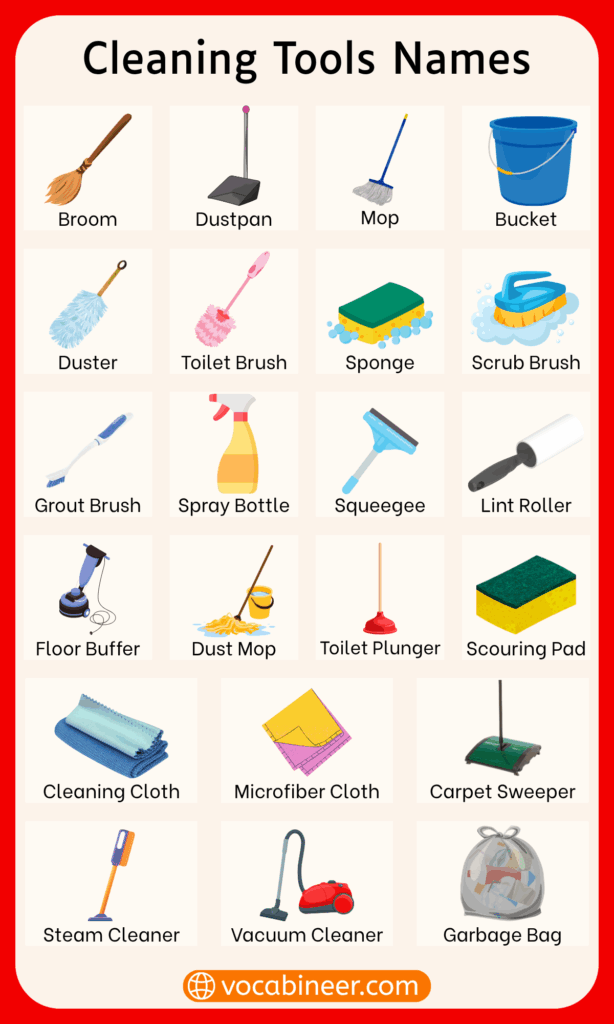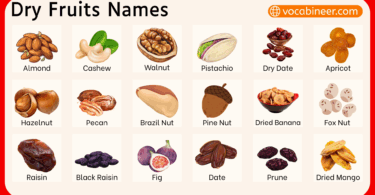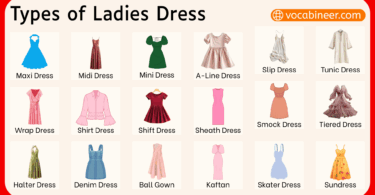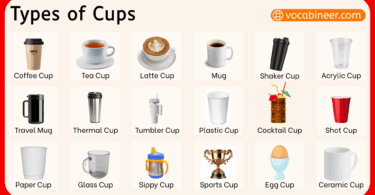Cleaning tools names in English with pictures help us understand what different items are called when we talk about keeping spaces clean. These tools are used in homes, kitchens, offices, and more to wipe, scrub, sweep, and disinfect things like floors, dishes, glass, or furniture. Each tool has a specific use, and learning their names helps describe cleaning tasks more confidently in English, especially when paired with pictures for easy recognition.
In This Page
Complete List of Cleaning Tools Names in English
This section introduces different categories of cleaning tools based on where and how they are used. Below is a list of tools with descriptions.
Common Household Cleaning Tools
- Broom: Used to sweep dust and debris from floors.
- Dustpan: A flat container used with a broom to collect swept dirt.
- Bucket: Holds water or cleaning solution during mopping or scrubbing.
- Vacuum Cleaner: A device that sucks up dirt from carpets and floors.
- Spray Bottle: Used to apply cleaning liquids on surfaces.
- Cleaning Gloves: Protect hands while using chemicals or touching dirty surfaces.
- Cleaning Caddy: A small container that helps carry multiple cleaning tools easily from room to room.
Floor Cleaning Equipment Names
- Mop: Used with water or disinfectant to clean hard floors.
- Spin Mop: A type of mop that can be wrung out using a spinning bucket.
- Floor Scrubber: A tool or machine used to scrub stains from floors.
- Floor Wiper: Helps push water off wet floors.
- Steam Mop: Uses steam to deep clean tiled or sealed floors.
- Dry Mop: Designed for dusting floors without any moisture.
- Carpet Sweeper: A manual tool to remove debris from rugs and carpets.
Surface and Furniture Cleaning Items
- Microfiber Cloth: A soft cloth that picks up dust and dirt easily.
- Surface Cleaner Spray: Liquid cleaner sprayed directly on surfaces.
- Furniture Polish: Applied to wooden furniture to clean and shine.
- Scrub Sponge: Has one soft side and one rough side for cleaning stubborn marks.
- Scouring Pad: A coarse pad used to scrub tougher surfaces.
- Lint Roller: Removes hair, lint, or dust from fabric or upholstery.
- All-Purpose Cleaner: Versatile solution used for cleaning multiple surface types.
Tools for Bathroom Cleaning
- Toilet Brush: Used to scrub inside the toilet bowl.
- Toilet Cleaner Gel: A thick liquid that helps clean and disinfect the toilet.
- Tile Scrub Brush: Cleans between tiles and on wet surfaces.
- Squeegee: Removes water from flat surfaces like shower walls or mirrors.
- Disinfectant Spray: Kills bacteria and viruses on bathroom surfaces.
- Pumice Stone: Helps remove mineral deposits or hard stains in toilets.
- Shower Cleaner Spray: Prevents soap and mildew buildup after each shower.
Kitchen Cleaning Tools
- Dishwashing Sponge: Soft and absorbent, used to clean plates and pans.
- Dish Brush: A brush with stiff bristles to scrub food residues.
- Dish Rack: Holds washed dishes so they can dry.
- Degreaser Spray: Helps clean oily surfaces in kitchens.
- Sink Plunger: Used to unblock clogged sinks.
- Scraper Blade: Used to remove stuck or burnt food from cookware.
- Oven Cleaning Spray: Cuts through thick grease in ovens and stovetops.
Cleaning Tools for Glass and Mirrors
- Glass Cleaner Spray: Removes fingerprints and smudges from glass.
- Lint-Free Cloth: A cloth that leaves no fiber residue.
- Window Wiper: A tool to slide water or cleaner off glass.
- Newspaper Sheets: Sometimes used with cleaner to polish glass.
- Glass Microfiber Pad: Specially designed pad for clear, streak-free wiping.
Dusting Tools and Accessories
- Feather Duster: Light and flexible, good for delicate items.
- Static Duster: Attracts dust using static electricity.
- Dusting Cloth: A soft cloth used for everyday dusting.
- Extendable Duster: Helps reach ceilings and tall corners.
- Keyboard Duster: A tiny brush or blower for cleaning small electronics and keyboards.
Cleaning Brushes Types
- Scrub Brush: Has strong bristles for rough surfaces.
- Bottle Brush: Cleans the insides of bottles and flasks.
- Grout Brush: Narrow and stiff, ideal for cleaning tile gaps.
- Shoe Brush: Used to clean shoes, especially leather ones.
- Nail Brush: A small brush used to clean fingers or tight spaces.
Wiping and Drying Cloths
- Paper Towels: Disposable sheets used for spills.
- Cotton Rags: Reusable cloths used for drying or wiping.
- Kitchen Towel: Absorbs water from dishes or hands.
- Polishing Cloth: Used for shining surfaces like glass or metal.
- Chamois Leather: Known for polishing windows or car surfaces.
- Drying Mat: Placed under dishes for air-drying after washing.

Manual vs Electric Cleaning Tools
Some tools work by hand, while others run on electricity to do the job faster.
Manual Cleaning Tools Names
- Broom
- Mop
- Brush
- Bucket
- Scrub Pad
- Dustpan
- Lint Roller
Electric Cleaning Equipment
- Vacuum Cleaner: Removes dust from floors, carpets, and sofas.
- Steam Cleaner: Uses hot steam to clean and disinfect.
- Electric Scrubber: Cleans floors, walls, or grout with rotating brushes.
- Automatic Window Cleaner: Sticks to windows and cleans them on its own.
- Robotic Vacuum: Moves on its own to clean floors automatically.
- Cordless Handheld Vacuum: Compact vacuum for small spaces or spot cleaning.
Specialized Cleaning Tools by Use
These are tools created for specific cleaning jobs or locations.
Disinfection and Sanitizing Tools
- Disinfectant Sprays
- Sanitizing Wipes
- UV Sanitizer Wands
- Bleach Applicators
- Electrostatic Sprayer: Used for even disinfection in healthcare or large areas.
Cleaning Tools for Commercial Spaces
- Ride-on Floor Scrubber: Used in malls and airports.
- Janitor’s Cart: Holds all cleaning supplies for easy movement.
- High-Pressure Cleaner: Cleans outdoor walls and sidewalks.
- Industrial Vacuum: Has a bigger tank and stronger suction.
- Auto-Scrubber Dryer: Cleans and dries large floors in one go.
Storage and Maintenance of Cleaning Tools
Cleaning tools last longer when they are stored properly and kept clean.
- Store mops upside down to dry.
- Keep brushes and sponges in dry places.
- Wash cloths after each use.
- Replace worn-out items regularly.
- Clean electric tools after each use following the manual.
- Keep all tools organized in a dry, accessible place.
FAQs about Cleaning Tools
A mop typically has absorbent strands for soaking up spills, while a floor wiper has a flat surface to push water away efficiently.
There’s a dedicated grout brush—it has narrow, stiff bristles that fit well into tile lines for effective deep cleaning.
Not exactly—steam mops sanitize hard floors, while a vacuum cleaner removes dirt from carpets and rugs, so they serve different cleaning roles.
Use a squeegee after showers to wipe water off glass doors or mirrors—this helps prevent water spots and mold growth.
Yes. Microfiber cloths trap dust and dirt more effectively than cotton rags, and they often need less cleaning solution to work well.
Read More




